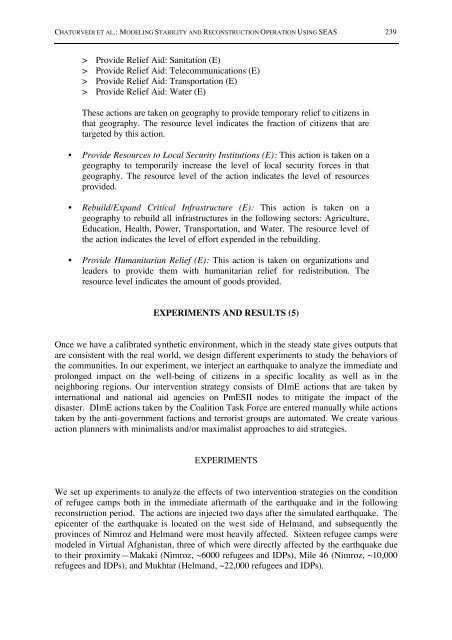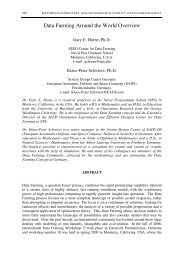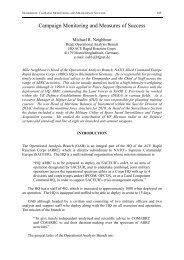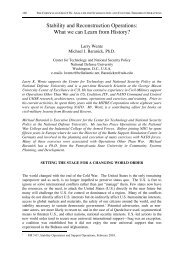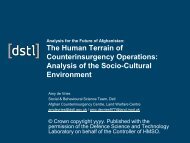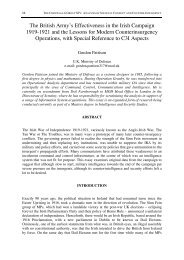Modeling Stability and Reconstruction Operation ... - Cornwallis Group
Modeling Stability and Reconstruction Operation ... - Cornwallis Group
Modeling Stability and Reconstruction Operation ... - Cornwallis Group
You also want an ePaper? Increase the reach of your titles
YUMPU automatically turns print PDFs into web optimized ePapers that Google loves.
CHATURVEDI ET AL.: MODELING STABILITY AND RECONSTRUCTION OPERATION USING SEAS 239> Provide Relief Aid: Sanitation (E)> Provide Relief Aid: Telecommunications (E)> Provide Relief Aid: Transportation (E)> Provide Relief Aid: Water (E)These actions are taken on geography to provide temporary relief to citizens inthat geography. The resource level indicates the fraction of citizens that aretargeted by this action.• Provide Resources to Local Security Institutions (E): This action is taken on ageography to temporarily increase the level of local security forces in thatgeography. The resource level of the action indicates the level of resourcesprovided.• Rebuild/Exp<strong>and</strong> Critical Infrastructure (E): This action is taken on ageography to rebuild all infrastructures in the following sectors: Agriculture,Education, Health, Power, Transportation, <strong>and</strong> Water. The resource level ofthe action indicates the level of effort expended in the rebuilding.• Provide Humanitarian Relief (E): This action is taken on organizations <strong>and</strong>leaders to provide them with humanitarian relief for redistribution. Theresource level indicates the amount of goods provided.EXPERIMENTS AND RESULTS (5)Once we have a calibrated synthetic environment, which in the steady state gives outputs thatare consistent with the real world, we design different experiments to study the behaviors ofthe communities. In our experiment, we interject an earthquake to analyze the immediate <strong>and</strong>prolonged impact on the well-being of citizens in a specific locality as well as in theneighboring regions. Our intervention strategy consists of DImE actions that are taken byinternational <strong>and</strong> national aid agencies on PmESII nodes to mitigate the impact of thedisaster. DImE actions taken by the Coalition Task Force are entered manually while actionstaken by the anti-government factions <strong>and</strong> terrorist groups are automated. We create variousaction planners with minimalists <strong>and</strong>/or maximalist approaches to aid strategies.EXPERIMENTSWe set up experiments to analyze the effects of two intervention strategies on the conditionof refugee camps both in the immediate aftermath of the earthquake <strong>and</strong> in the followingreconstruction period. The actions are injected two days after the simulated earthquake. Theepicenter of the earthquake is located on the west side of Helm<strong>and</strong>, <strong>and</strong> subsequently theprovinces of Nimroz <strong>and</strong> Helm<strong>and</strong> were most heavily affected. Sixteen refugee camps weremodeled in Virtual Afghanistan, three of which were directly affected by the earthquake dueto their proximity—Makaki (Nimroz, ~6000 refugees <strong>and</strong> IDPs), Mile 46 (Nimroz, ~10,000refugees <strong>and</strong> IDPs), <strong>and</strong> Mukhtar (Helm<strong>and</strong>, ~22,000 refugees <strong>and</strong> IDPs).


